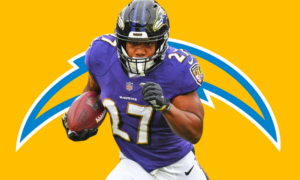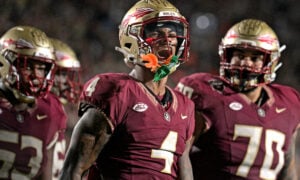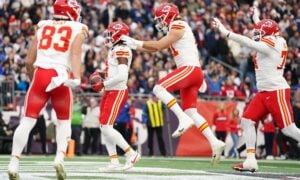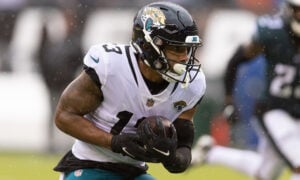An Approach to Auction and Salary Cap/Contract Leagues

First, I think that a start-up auction is the best way to complete a fantasy draft, regardless of whether it’s a dynasty or re-draft league. Not only is it more fun than the traditional snake draft format, but it also allows each owner a fair chance to obtain any given player and increases the strategic element of the draft process. Anyone can sit there and follow an ADP sheet or pick players in order from a list of player rankings. Auction drafts separate the men from the boys (or women from the girls).
Second, I believe a salary cap/contract league is the toughest dynasty format to play in and that may be why every dynasty owner doesn’t partake in them. If you haven’t had this experience, I highly recommend it. Much like an auction draft, everyone can have a completely different strategy and still be successful. You have to consider so many different factors when making a “simple” trade. It’s great!
Lucky for you, I’ve got you covered on both and hopefully this makes your life a lot easier.
GENERAL AUCTION STRATEGY
Fellow DLF writer George Kritikos already wrote this article regarding auction strategy back in June and I highly recommend you read it either before or after reading this article. I will not give you any duplicate content, but will add some insight and give you some additional strategy.
Overall strategy: Put together a strategy of how you want to approach the draft from a team composition standpoint. Do you want to be top heavy with a few studs and then go after values players later on? Do you want to forego the studs and instead have a very deep, quality roster throughout? Do you want to focus on veterans, youth, or a solid mix of both? While I recommend having a plan going into the draft, you also need to be flexible. Every auction draft (or dynasty draft period) is different. The best way to come out of an auction draft on top is to “zig while others zag.” If the owners in your league want to go wide receiver heavy, then scoop up a top tier QB, RB, or TE at a discount. If the whole league wants to focus on youth, then draft to win now and focus on veterans or a mix.
[am4show have=’g1;’ guest_error=’sub_message’ user_error=’sub_message’ ]
Separating by tiers: Much like George, I prefer to separate players into tiers prior to the draft. However, I take it a step further and I will separate players into tiers twice. The first being my own player tiers based on my personal rankings and the second being by “consensus” rankings – this helps me identify players not to go after and players I believe can be had at a value. I also separate them by tiers both ways to determine when the last player in my personal tier is available and when the last player in the “consensus” is available (I will go into why I do this later).
Bidding habits: I typically treat an auction like a poker game. Every owner bids differently and has their unique habits or “tells.” You have the player who likes to raise aggressively on EVERY hand and the player who is timid and a little bullying makes him fold pretty quickly, along with everything in between. Similar to a poker game, I will try to pick up on everyone else’s tells. To quote Mike McDermott from Rounders (played by Matt Damon), “Listen, here’s the thing. If you can’t spot the sucker in your first half hour at the table, then YOU are the sucker.” To ensure I’m not the “sucker,” I will monitor my own bidding habits and make sure I never start forming any type of pattern. Just like poker, if you only bid heavily or consistently on the players you really want (hands where you have good cards) and don’t bid at all on ones you don’t (poor cards), people will start to pick up on that and drive up the price when they know you want a player. I will bid on a few players I really do want, but use different techniques. On one player I’ll be really aggressive and bid early and often. On the next player I’ll sand bag for most of the auction and then swoop in with a big last minute bid and take him. After that, I’ll use the same techniques and bid on players I don’t actually want.
Player nominations: Typically I will only nominate two types of players through the earlier stages in the auction. The first type is any player the “consensus” rankings have much higher than I do. Martavis Bryant or Allen Robinson fit into that category this year for me. The second types are the highest remaining players at a position that I have already “filled.” If I scooped up Aaron Rodgers and Rob Gronkowski early on in the auction, then I would start throwing out players like Russell Wilson, Jimmy Graham and Travis Kelce to try and soak up some of the remaining cap space.
Save some money until the end: When I went into my first auction draft I was given this same advice and I DID NOT FOLLOW IT, so please do yourself a favor and listen to me. During auction drafts it’s very easy to get caught up in the fun and excitement, creating the potential to lose track of your money. Towards the end of the auction over half of the league won’t be able to bid more than the minimum bid ($1 typically) or these owners will be running short on roster spots. For this reason, if you hold on to some cash until the latter part of the auction, you will come out with some nice values.
Go get your guy: The nice thing about an auction is you can truly have any player that you want. It’s just a matter of what the cost is and what you lose out on as a result (we will discuss this further in a minute). Whether it’s a top tier stud or a mid-level player, feel free to pay up for “your guys” a few times during the auction. Just don’t go overboard. If you like Antonio Brown, and Dez Bryant and Julio Jones went for $33 and $35 respectively, feel free to spend $37 on Brown. Just don’t spend $45!
SALARY CAP/CONTRACT STRATEGY
Do not overpay for running backs: Running back is the most volatile position in fantasy football, and due to the amount of turnover at the position, they are simply not worth paying top dollar for and locking into a multi-year contract. To give you an example, I completed a start-up draft in 2013 and eight running backs were taken in the first 15 picks. Those players were Arian Foster, Ray Rice, Trent Richardson, Doug Martin, Jamaal Charles, Adrian Peterson, LeSean McCoy and CJ Spiller. As you can see, just two years later a majority of those running backs are an afterthought and not worth the premium price an owner likely paid for them in an auction in 2013. While players like Le’veon Bell and Eddie Lacy might look safe now, things can change quickly.
Don’t get stuck bidding on the last guy in a tier: If you or the “consensus” have several players at a position ranked in the same tier, make sure you grab one of the players earlier rather than later. You don’t want to get stuck bidding on the last guy in a particular tier. For example, if you view six wide receivers in the “elite” tier, lock one of them up before the sixth comes up for bidding. If you have eight owners who have a goal of landing an “elite” tier wide receiver and there are only six available, this is going to create a bidding war for last player out there in that tier. It’s simple supply and demand. Let someone else get into a bidding war and overpay.
Be aware of expiring contracts and future cap space: Due to the structure of a salary cap/contract league, you are always going to have multiple players on expiring contracts at the same time. Make sure you budget accordingly for this. If you have Eddie Lacy and Sammy Watkins both on expiring contracts two years from now, plan accordingly and ensure that you have enough future cap space to potentially resign them at a higher cost. Another strategy I like to employ is acquiring multiple first round draft picks in a year that I know I have several players on expiring contracts. This allows me to “re-stock” cheaply at the right time.
Top tier rookie picks are gold: Having the ability to lock up a young stud like Mike Evans or Todd Gurley cheaply is very beneficial in a salary cap/contract league.
Immediate production is key when selecting rookies: Due to short contract lengths, you only have so many years for a player to develop. For that reason it is not to your advantage to draft players who are “raw” and will take several years to develop. Quarterbacks and tight ends are also devalued in this format, as they typically take longer to become fantasy relevant.
Analyzing trades and roster moves: The basic economic principle “opportunity cost” is defined as the loss of potential gain from other alternatives when one alternative is chosen – this is what salary cap/contract leagues (and auctions) are all about and this is why they are so difficult. You can have “X” and “Y”, but at the cost of “Z.” In a traditional dynasty league you can just trade player “X” for player “Y” straight up and as long as both sides agree the trade is fair, then you pull the trigger. In a salary cap/contract league you have to consider the overall value of the players, your current cap situation, the other owners cap situation, the salaries of all players being traded and the length of the contracts. This makes it much more difficult. Salary cap/contract leagues are also unique because not only do the players themselves carry value, but open cap space also carries value. This is due to the fact you can spend that money on players in free agency the following season and essentially get something in return for the open cap space.
Let’s take a look at two trade proposals from one of my salary cap leagues and I will walk you through my thought process when evaluating each trade:
Trade offer #1:
-This was a ten team, non PPR, 21 player roster, $1,100 cap league.
-Going into our free agency period I was looking to add a quality QB2, a solid RB, and some depth at WR.
The following trade was offered to me:
I give: Markus Wheaton ($13, 2 years)
I get: Matthew Stafford ($56, 4 years)
In a traditional dynasty league, I’m sure every owner would jump at the chance to acquire Stafford for Wheaton. In this league it was a much harder decision. I am not very high on Wheaton and Stafford would be a rock solid QB2 for me going forward that could eventually take over for Ryan, so I was onboard from a value perspective. I then had to consider the salary cap difference and potential replacement options. The $43 salary difference in salaries would land me a player along the lines of Doug Martin or Jarvis Landry, or a combination of players such as Ryan Tannehill and Larry Fitzgerald. This is where the opportunity cost comes into play. The trade goes from being Wheaton for Stafford straight up, to being Wheaton/Tannehill/Fitzgerald or Wheaton/Martin for Stafford when you consider what that extra $43 could buy me. I declined the trade for that reason.
Trade offer #2:
–This a ten team, non PPR, 21 player roster, $1,100 cap league.
–This trade was proposed to me in 2014, just after week five had ended.
-AJ Green was on an expiring contract and I knew that I would not have the money to resign him during the 2015 offseason.
-AJ Green had just injured his toe during week five and had already been ruled out for week six, with no timetable for his return.
-I had some depth at WR and was looking for a solid RB2 to pair with Marshawn Lynch.
The following trade was offered to me:
I give: AJ Green ($60, 1 year), Marqise Lee ($10, 3 years)
I get: Giovani Bernard ($80, 2 years)
As you can see, the cap money was pretty much a wash, so that didn’t really factor in. I preferred Green to Bernard from a value perspective, but the difference wasn’t that large (this is before Jeremy Hill took over.) Due to Green’s contract expiring at the end of the season, I essentially had to treat him like a re-draft player. At that point, there were a possible 11 games Green could’ve played on my team (if I made the playoffs) and he had already been ruled out for one of them and it looked like he might miss another. With the injury factored in, it basically came down to nine games with Green or 27 games with Bernard, with Lee being a very minor factor. I ultimately took the trade because I felt 27 games out of Bernard were much better than nine games out of Green. I also had to factor in the potential I didn’t make the playoffs, taking another three games away from Green’s side. While the trade didn’t quite work out how I had hoped due to Bernard getting injured and Jeremy Hill taking over, I think it was ultimately still a win.
Do you have any salary cap/contract questions? Follow me on Twitter: @Bryan_J_Murphy
[/am4show]
- Chicago-style Deep Dish - October 18, 2015
- An Approach to Auction and Salary Cap/Contract Leagues - August 20, 2015
- Calvin and Cobb - August 9, 2015


































































